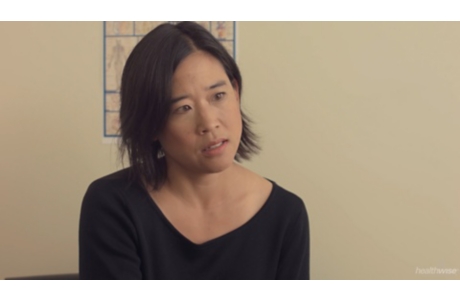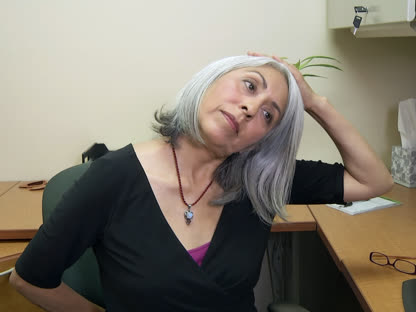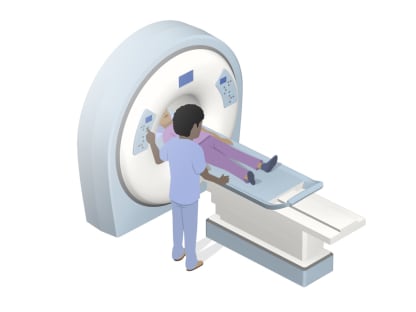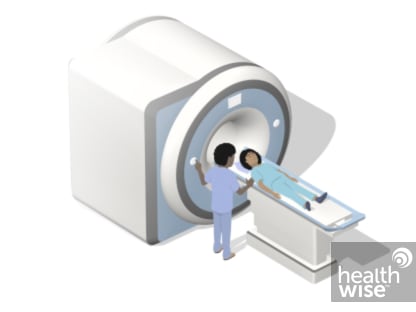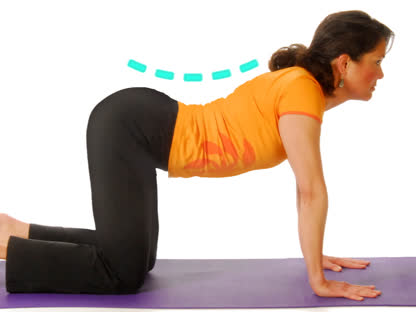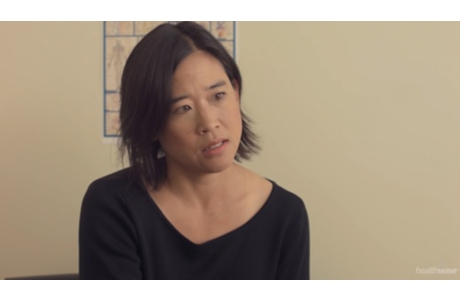Neck Pain
Condition Basics
What is neck pain?
Neck pain is pain that can occur anywhere in your neck, from the bottom of your head to the top of your shoulders. It can spread to your upper back or arms. It may limit how much you can move your head and neck.
Neck pain is common, especially in people older than 50.
What causes it?
Neck pain can be caused by activities that strain the neck, such as slouching, painting a ceiling, or sleeping with your neck twisted. It can also be caused by an injury, such as a fall or whiplash from a car accident. Some medical problems can cause it. Sometimes there is no clear cause.
What are the symptoms?
You may feel a knot, stiffness, or severe pain in your neck. It may spread to your shoulders, upper back, or arms. You may get a headache. It may be hard to turn your head. You might have shooting pain, numbness, tingling, or weakness in your arm.
How is it diagnosed?
Your doctor will ask about your symptoms and possible causes of your neck pain. You'll be checked to see how well you can move your neck and for tenderness, numbness, tingling, or weakness in your arms or hands. You may get X-rays. Your doctor may do blood tests to check for infection or illness.
How is neck pain treated?
Most neck pain can be treated at home. Try a heating pad or ice for 10 to 15 minutes every few hours. Avoid more injury by changing how you sit or sleep. Try physical therapy. Your doctor may suggest anti-inflammatory medicine or prescribe other medicines. Surgery is rarely done.
How can you prevent neck pain?
You can avoid some neck pain with new habits. Avoid spending time in positions that stress your neck. Sit straight in your chair with your feet flat on the floor. Take short breaks. Don't sleep on your stomach with your neck twisted. Try using pillows that keep your neck straight.
Related Videos
Health Tools help you make wise health decisions or take action to improve your health.
Neck pain can be caused by activities that strain the neck. Slouching, painting a ceiling, or sleeping with your neck twisted are some things that can cause neck pain. These kinds of activities can lead to neck strain, a sprain, or a spasm of the neck muscles.
Neck pain can also be caused by an injury. A fall from a ladder or whiplash from a car accident can cause neck pain. Some less common medical problems can also lead to neck pain, such as:
- An infection in the neck.
- Narrowing of the spinal canal in the neck (cervical spinal stenosis).
- Rheumatoid arthritis.
Sometimes neck pain may not have a clear cause.
You can avoid neck pain caused by stress or muscle strain with some new habits.
Here are some things to try:
- Avoid spending a lot of time in positions that stress your neck. This can include sitting at a computer for a long time.
- If your neck pain is worse at the end of the day, think about how you sit during the day. Sit straight in your chair with your feet flat on the floor. Take short breaks several times an hour.
- If your neck pain is worse in the morning, check your pillow and the position you sleep in, Opens dialog. Use a pillow that keeps your neck straight. Don't sleep on your stomach with your neck twisted or bent.
- If stress is adding to your neck pain, practice relaxation exercises. Consider getting a massage.
- Strengthen and protect your neck by doing neck exercises once a day.
- Stay at a healthy body weight.
Learn more
Watch
You may feel a knot, stiffness, or severe pain in your neck. The pain may be worse when you move. It may spread to your shoulders, upper back, or arms. You may get a headache. You may not be able to move or turn your head and neck easily.
If there is pressure on a spinal nerve root, Opens dialog, you might have pain that shoots down your arm. You may also have numbness, tingling, or weakness in your arm. You may also have a burning feeling when you are touched on the skin of the arm or hand. There might also be pain that feels like a shock and extends into your arm or hand.
If your neck pain is long-lasting (chronic), you may have trouble coping with daily life. Common side effects of chronic pain include fatigue, depression, and anxiety.
Most neck pain gets better within several weeks with treatment that includes taking steps to relieve pain, modifying activities, and doing exercises or manual therapy, Opens dialog. Neck pain caused by an injury such as a severe whiplash may take longer but usually improves in 6 to 12 months.
Neck pain may become long-lasting (chronic) when it occurs in combination with other health conditions, such as conditions associated with increasing age. These include narrowing of the spinal canal (cervical spinal stenosis), arthritis of the neck (cervical spondylosis), or herniated disc, Opens dialog. In some cases, chronic neck pain can be caused by repeated and prolonged movements, such as long hours working at a computer.
Chronic neck pain can make it hard to cope with daily life. Common side effects of chronic pain include fatigue, depression, and anxiety.
Learn more
Call 911 or other emergency services immediately if:
- Neck pain occurs with chest pain or other symptoms of a heart attack, Opens dialog, such as shortness of breath and nausea.
- A person has signs of damage to the spine after an injury (such as a car crash, fall, or direct blow to the spine). Signs may include:
- Being unable to move part of the body.
- Severe back or neck pain.
- Weakness, tingling, or numbness in the arms or legs.
Call your doctor now or seek immediate medical care if:
- You have new or worse numbness in your arms, buttocks or legs.
- You have new or worse weakness in your arms or legs. (This could make it hard to stand up.)
- You lose control of your bladder or bowels.
- You have long-term neck pain that suddenly gets much worse, and you didn't cause it by being more active.
- You have a history of cancer or HIV infection, and you have new or increased neck pain.
- Pain wakes you from sleep.
Watchful waiting
Most neck pain doesn't require a visit to a doctor.
If the pain doesn't get better after 1 or 2 days and you can't do your normal daily activities, call your doctor.
If you still have mild to moderate pain after at least 2 weeks of home treatment, talk with your doctor. You may need to be checked for problems that may be causing your neck pain.
Check your symptoms
Your doctor will ask questions about your symptoms and do a physical exam. He or she may also ask about any injuries, illnesses, or activities that may be causing your neck pain, as well as any previous treatment you've had.
During the physical exam, your doctor will check how well you can move your neck. He or she will also look for tenderness or numbness, tingling, or weakness in your arms or hands.
You may have blood tests to check for an illness or infection.
Imaging, electromyogram, and nerve conduction tests
You may not need X-rays or other imaging tests, Opens dialog. But if your pain started after an injury, or if it doesn't improve after a few weeks, your doctor may want to do more tests. Imaging tests can show the neck muscles and tissues. These tests may be done to check the neck bones, spinal discs, Opens dialog, spinal nerve roots, Opens dialog, and spinal cord, Opens dialog.
Imaging tests may help especially when:
- You have signs of nerve damage.
- Another serious problem is suspected.
- The cause of your problem isn't clear.
- Nonsurgical treatment has not improved your condition and you are thinking about surgery.
- Your doctor is asked to provide documentation of your condition, such as when a lawsuit or an insurance issue is involved.
Besides X-rays, tests may include:
- MRI, Opens dialog. It can help identify problems such as a herniated disc or a pinched nerve.
- CT scan, Opens dialog. This test looks at the bone and spinal canal.
- Myelogram, Opens dialog. It looks at the spinal canal and nerve roots.
- Electromyogram, Opens dialog and nerve conduction studies, Opens dialog or nerve blocks. These tests can help find a nerve problem that is causing pain, numbness, or weakness in the arm or hand.
Learn more
Watch
The type of treatment you need depends on the cause of your neck pain. Most neck pain caused by activities can be treated at home.
For neck pain that occurs suddenly:
- Use a heating pad on a low or medium setting for 15 to 20 minutes every 2 to 3 hours. Or you can try an ice pack for 10 to 15 minutes every 2 to 3 hours.
- Avoid more neck injury by changing some habits, such as how you sit or sleep.
- Work with a physical therapist, chiropractor, or osteopathic doctor for exercises or manual therapy, Opens dialog. Massage or yoga may help.
Ask your doctor if you can take an anti-inflammatory, Opens dialog medicine for pain.
For chronic neck pain, your doctor may prescribe medicine to relax your neck muscles, relieve pain, or help you sleep.
Surgery is rarely done to treat neck pain.
Learn more
Use heat or ice
There is no strong evidence that either heat or ice will help your neck pain. But it won't hurt to try them.
- Use a heating pad.
Use it on a low or medium setting for 15 to 20 minutes every 2 to 3 hours.
- Take a warm shower.
Do this in place of one session with the heating pad.
- Try single-use heat wraps.
You can buy ones that last up to 8 hours.
- Try an ice pack.
Use it for 10 to 15 minutes every 2 to 3 hours.
Get moving, but carefully
As soon as you can, get moving. This can help speed your recovery from neck pain.
- Ease back into your normal daily activities.
Movement helps your muscles stay strong.
- Do stretching and strengthening exercises for your neck.
They will keep your neck flexible and strong and prevent stiffness.
Use good health habits
You can treat neck pain at home with some new habits. Here are some steps you can take to help you feel better.
- Try to reduce stress and tension at work and home.
- Practice relaxation exercises.
- Consider getting a massage.
Or gently massage the area yourself.
- Stop smoking.
Smoking slows healing because it decreases blood supply and delays tissue repair.
- Exercise regularly.
Include aerobic exercise such as walking.
- Avoid or change activities that cause neck pain.
Examples include sitting for a long time at the computer or doing too much overhead work at a time.
- Avoid activities that make pain and stiffness worse.
Examples include lifting and sports.
Learn more
Watch
Medicines can relieve neck pain and reduce inflammation of the soft tissues. Pain relief will allow you to move your neck gently, so you can begin easy exercises and start to heal.
Nonprescription pain relievers include:
- Creams or gels that are rubbed into the neck.
- Acetaminophen (such as Tylenol). It reduces pain.
- Nonsteroidal anti-inflammatory drugs (NSAIDs), Opens dialog, including ibuprofen (such as Advil) and naproxen (such as Aleve). They can help relieve pain and reduce inflammation.
Prescription pain relievers include:
- Muscle relaxants. They are used to treat severe neck pain and spasms when neck pain begins.
- Opioid, Opens dialog pain relievers. They are used to treat severe short-term neck pain.
- Antidepressants. They are used to treat long-lasting pain.
- Corticosteroid injections, Opens dialog. These may be tried if you also have symptoms of a pinched or irritated nerve root.
- Anticonvulsants. They may help reduce long-term neck pain. One type may work better for you than another.
Learn more
Surgery is rarely needed for neck pain. It may be an option when:
- A neck injury causes a fracture or abnormal motion. Surgery may be done to stabilize the spine and prevent a broken bone from causing instability and possible paralysis.
- Pressure on the nerve roots or spinal cord, Opens dialog causes numbness or weakness in the arm, hand, or leg; severe ongoing pain; or loss of bladder or bowel control. Pressure may be caused by problems like narrowing of the spinal canal, Opens dialog, arthritis of the neck, or a herniated disc in the neck.
Surgeries include:
- Discectomy. The surgeon removes herniated disc material that's pressing on a nerve root or the spinal cord.
- Spinal decompression. Pressure is reduced on the spinal cord or nerve roots by removing part of a bone or disc, Opens dialog.
- Cervical spinal fusion. Selected bones in the neck are joined (fused) together.
- Artificial disc replacement. This may be done instead of spinal fusion.
Learn more
Complementary medicine treatments, Opens dialog are sometimes used to relieve neck pain and restore neck mobility. They include:
- Acupuncture, Opens dialog. This is done by inserting very thin needles into the skin. It's used to relieve pain.
- Massage. It helps with relaxation. It also helps reduce pain and increase flexibility.
- Yoga or qi gong. These are programs of exercises. They help improve flexibility and breathing, decrease stress, and maintain health.
Find out about the safety of any complementary product or practice you want to try. Most mind and body practices—such as acupuncture, massage, and yoga—are safe when used under the care of a well-trained professional. Choose an instructor or practitioner as carefully as you would choose a doctor.
Talk with your doctor about any complementary health practice that you would like to try or are already using. Your doctor can help you manage your health better if he or she knows about all of your health practices.
Learn more
Watch
Current as of: July 31, 2024
Author: Ignite Healthwise, LLC Staff
Clinical Review Board
All Healthwise education is reviewed by a team that includes physicians, nurses, advanced practitioners, registered dieticians, and other healthcare professionals.
Current as of: July 31, 2024
Author: Ignite Healthwise, LLC Staff
Clinical Review Board
All Healthwise education is reviewed by a team that includes physicians, nurses, advanced practitioners, registered dieticians, and other healthcare professionals.
Topic Contents
This information does not replace the advice of a doctor. Ignite Healthwise, LLC, disclaims any warranty or liability for your use of this information. Your use of this information means that you agree to the Terms of Use. Learn how we develop our content.

